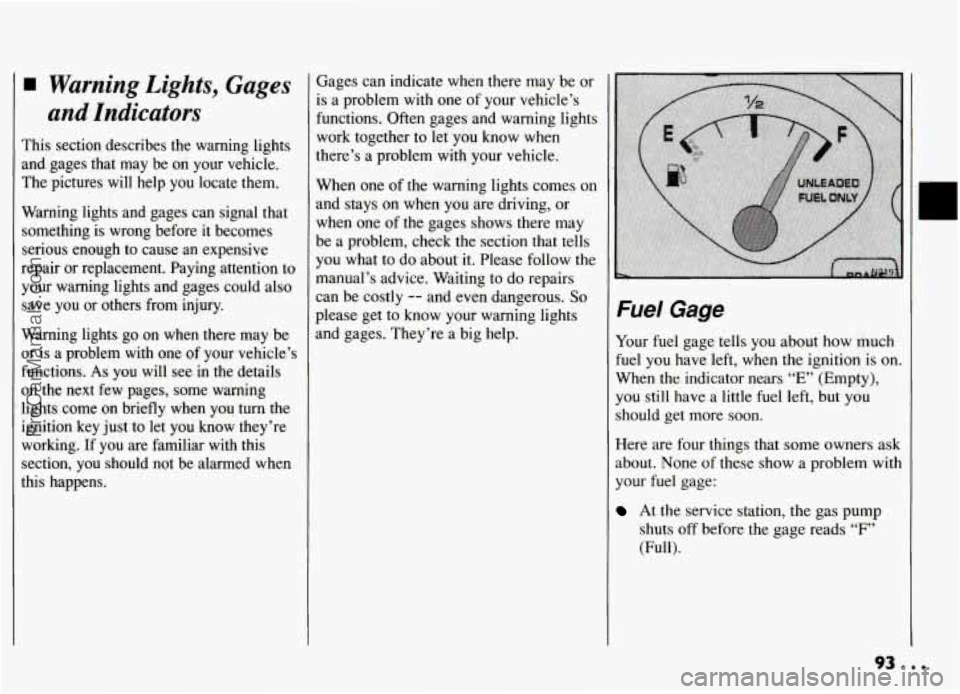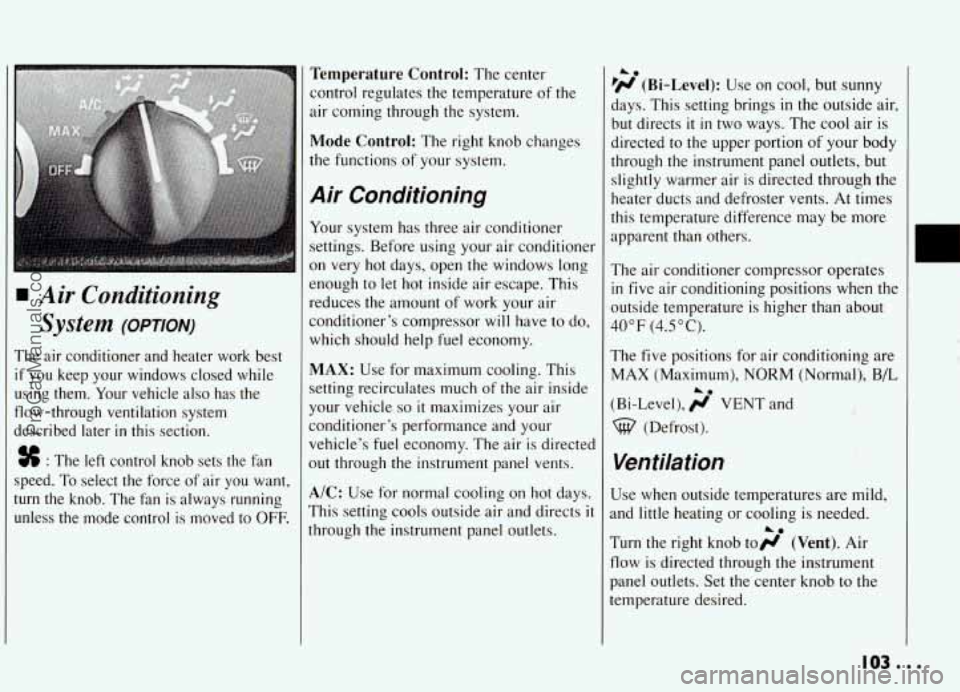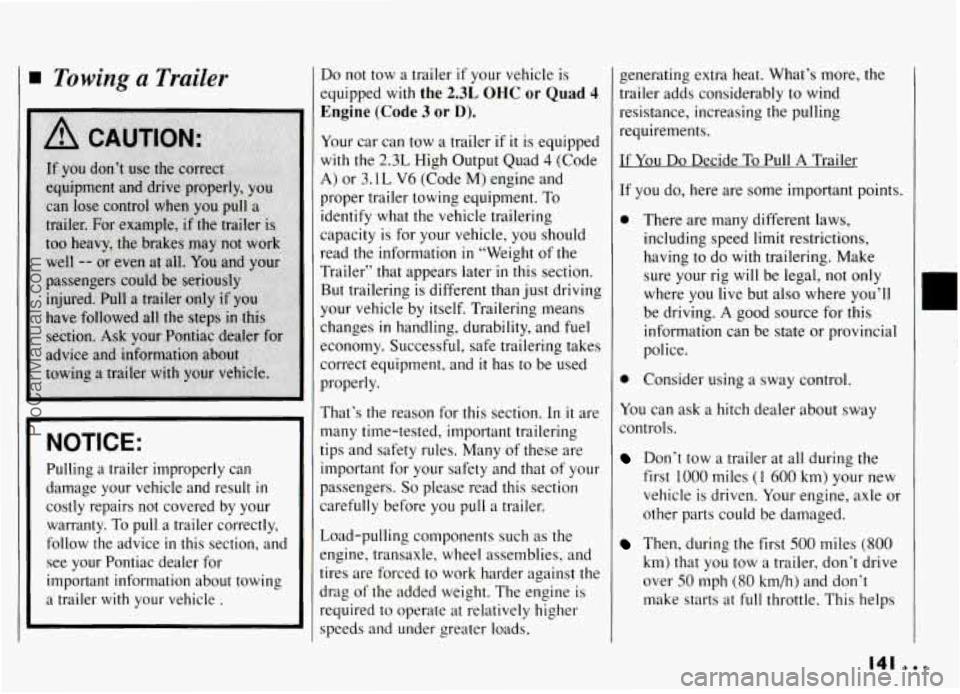1994 PONTIAC GRAND-AM fuel
[x] Cancel search: fuelPage 94 of 274

Warning Lights, Gages
and Indicators
This section describes the warning lights
and gages that may be on your vehicle. The pictures will help you locate them.
Warning lights and gages can signal that
something is wroug before it becomes
serious enough to cause an expensive
repair or replacement. Paying attention to
your warning lights and gages could also
save you
or others from injury.
Warning lights go on when there may be
Dr is a problem with one of your vehicle’s
functions. As you will see
in the details
on the next few pages, some warning
lights come on briefly
when you turn the
ignition key just to let you know they’re
working. If you are familiar with this
section, you should not be alarmed when
this happens.
Gages can indicate when there may be or
is a problem with one of your vehicle’s
functions. Often gages and warning lights
work together to let you know when
there’s a problem with your vehicle.
When one of the warning lights comes on
and stays on when you are driving, or
when one of the gages shows there may
be a problem, check the section that tells
you what to do about
it. Please follow the
manual’s advice. Waiting to do repairs
can
be costly -- and even dangerous. So
please get to know your warning lights
and gages. They’re
a big help.
Fuel Gage
Your fuel gage tells you about how much
fuel you have left, when the ignition is on.
When
the indicator nears “E” (Empty),
you still have a little
fuel left, but you
should get more soon.
Here are four things that some owners ask
about. None of these show a problem with
your fuel gage:
At the service station, the gas pump
shuts off before the gage reads “F”
(Full).
c
93...
ProCarManuals.com
Page 95 of 274

Features & Controls
Fuel Gage (CONT.)
0 It takes a little more or less fuel to fill
up than the gage indicated. For
example, the gage may have indicated
the tank was half full, but it actually
took a little more or less than half the
tank’s capacity to fill the tank.
0 The gage moves a little when you turn
a corner or speed up.
0 The gage doesn’t go back to “E” when
you turn off the ignition.
For your fuel tank capacity, see “Service
Station Information”
on the last page of
this manual.
Engine Coolant Temperature Warning
Light
This light tells you that your engine
coolant has overheated or your radiator
cooling fan is not working.
If you have been operating your vehicle
under normal driving conditions, you should pull
off the road, stop your vehicle
and
turn the engine off as soon as possible
HOT COOLANT CAN BURN YOU
BADLY!
In “Problems on the Road”, this manual
shows what to do. See “Engine
Overheating” in the Index.
Engine Coolant
Temperature Gage
This gage shows the engine coolant
temperature. If the gage pointer moves
into the red area, your engine is too hot!
That reading means the same thing as the
warning light. It means that your engine
coolant has overheated.
If you have been operating your vehicle
under normal driving conditions, you
should pull
off the road, stop your vehicle
and
turn off the engine as soon as possible.
HOT COOLANT CAN BURN YOU
BADLY!
In “Problems on the Road”, this manual shows what to do. See “Engine
Overheating” in the Index.
ProCarManuals.com
Page 101 of 274

Features & Controls
SERVICE
ENGINE
SOON
‘Malfunction Indicator
Lamp (Service Engine
Soon Light)
1 computer monitors operation of your
uel, ignition and emission control
,ystems. This light should come on when
he ignition is
on, but the engine is not
,unning, as a check to show you it is
working. If
it does not come on at all,
lave
it fixed right away. If it stays on, or
t comes on while you are driving, the
:omputer is indicating that you have a
aoblem.
You should take your vehicle in
or service soon.
NOTICE:
If you keep driving your vehicle
with
this light on, after a while the
emission controls won’t work as
well, your fuel economy won’t be as
good and your engine may not
run
as smoothly. This could lead to
costly repairs not covered by your
warranty.
CHECK
GAUGES
Check Gauges Light
(OPTION)
This light will come on briefly when you
are starting the engine. If the
light comes
on and stays
on while you are driving,
check your various gauges to see
if they
are
in the warning zones.
e.. 100
ProCarManuals.com
Page 104 of 274

Air Conditioning
System (OPTION)
The air conditioner and heater work best
if you keep your windaws closed while
using them. Your vehicle also has the
flow-through ventilation system
described later
in this section.
% : The left control knob sets the fan
speed. To select the force of air you want,
turn the knob. The fan is always running
unless the mode control is moved to
OFF.
Temperature Control: The center
control regulates the temperature of the
air coming through the system.
Mode Control: The right knob changes
the functions of your system.
A.ir Conditioning
Your system has three air conditioner
settings. Before using your air conditioner
on
very hot days, open the windows long
enough to let hot inside air escape. This
reduces the amount of work your air
conditioner’s compressor will have to do,
which should help fuel economy.
MAX: Use for maximum cooling. This
setting recirculates much of the air inside
your vehicle
SO it maximizes your air
conditioner’s performance and your
vehicle’s fuel economy. The air
is directed
out through the instrument panel vents.
A/C: Use for normal cooling on hot days.
This setting cools outside air and directs
it
through the instrument panel outlets.
he
lH (Bi-Level): Use on cool, but sunny
days. This setting brings
in the outside air,
but directs
it in two ways. The cool air is
directed to the upper portion of your body
through the instrument panel outlets, but
slightly warmer air is directed through the
heater ducts and defroster vents. At times
this temperature difference may be more
apparent than others.
The air conditioner compressor operates
in five air conditioning positions when the
outside temperature is higher than about
40°F (4.5”C).
The five positions for air conditioniqg are
MAX (Maximum), NORM (Normal.), B/L
(Bi-Level), ;j’ VENT and
%@ (Defrost). .. ._.
1. . ;>. w >%:
Ventilation
Use when outside temperatures are mild,
and little heating or cooling
is needed.
Turn the right knob toH (Vent). Air
flow is directed through the instrument
panel outlets. Set the center knob to the
temperature desired.
i.
IOS...
ProCarManuals.com
Page 105 of 274

Comfort Controls & Audio Systems
I Heating
Turning the right control knob to
(Heater) and the center control knob
clockwise
will send heated air through the
heater ducts toward your feet and the
floor, and some through the defroster
vents.
I ;j’ (Vent) and wo (Heater) are
economical positions because the air
conditioner compressor doesn’t
run in
these two settings. This reduces engine
load, resulting
in improved fuel economy.
If either setting fails to keep you
comfortable, or causes your windows to
fog up, turn
the right control knob to one
of the air conditioning positions, or to
%-$ (Defrost).
If you have the optional engine coolant
heater (engine block heater) and use
it
during cold weather, 0” F (- 18 O C) or
lower, your heating system
will more
quickly provide heat because the engine
coolant is already warmed. See “Engine
Coolant Heater” (Engine Block Heater)
the Index.
%?a pjd (Blend): This setting,divides air flow
Zqually between the heater ducts and the
windshield defroster vents.
Defrosting
Thew (Defrost) setting directs most air
through the defroster vents, and some
through the heater ducts.
Defogging Windows with
Air Conditioning System
To defog the windshield, turn all three
control knobs to the far right.
To defog the side windows, turn the right
control knob to pi (Bi-Level) and the
fan control knob to HIGH. Aim the side
vents toward the side windows. For
increased air flow to the side vents, close
the center vents.
A0
. . . IO4
ProCarManuals.com
Page 134 of 274

At the entrance there is usually a ramp
that leads to the freeway. If you have a
clear view of the freeway as you drive
along
the entrance ramp, you should
begin to check traffic. Try to determine
where you expect
to blend with the flow.
Try to merge into the gap at close
to the
prevailing speed. Switch on your turn signal, check your mirrors and glance
over your shoulder as often as necessary.
Try to blend smoothly with the traffic
flow.
Once you are on the freeway, adjust your
speed to the posted limit or to the
prevailing rate if it’s slower. Stay in the
right lane unless you want to pass.
Before changing lanes, check your
mirrors. Then use your turn signal.
Just before you leave the lane, glance
quickly over your shoulder to make sure
there isn’t another vehicle in your “blind”
spot.
Once you are moving on the freeway,
make certain you allow a reasonable following distance. Expect to move
slightly slower at night.
When you want to leave the freeway,
move to the proper lane well
in advance.
If you-miss your exit do not; under any
circumstances, stop and back
up. Drive on
to the next exit.
The exit ramp can be curved, sometimes
quite sharply.
The exit speed is usually posted.
Reduce your speed according to your
speedometer, not to your sense of motion.
After driving for any distance at higher
speeds, you may tend to think you are
going slower than you actually are.
Before Leaving on a
Long Trip
Make sure you’re ready. Try to be well
rested. If
you must start when you’re not
fresh
-- such as after a day’s work --
don’t plan to make too many miles that
first part of the journey. Wear comfortable
clothing and shoes you can easily drive
in.
Is your vehicle ready for a long trip? If
you keep it serviced and maintained, it’s
ready to go. If it needs service, have it
done before starting out. .Of course, you’ll
find experienced and able service experts
in Pontiac dealerships all across North
America. They’ll be ready and willing to
help if you need it.
Here are some things you can check
before a trip:
0
0
0
0
0
0
0
Windshield Washer Fluid: Is the
reservoir full? Are all windows clean
inside and outside?
Wiper Blades: Are they in good
shape?
Fuel, Engine Oil. Other Fluids: Have
you checked all levels?
Lights:’
Are they all working? Are the
lenses clean?
Tires: They are vitally important to a
safe, trouble-free trip. Is the tread
good enough for long-distance
driving?
Are the tires all inflated to
the recommended pressure?
Weather Forecasts: What’s the
weather outlook along your route?
Should you delay your trip a short
time to avoid a major storm system?
Maps: Do you have up-to-date maps?
133...
ProCarManuals.com
Page 139 of 274

Your Driving and the Road
If You’re Caught in a
Blizzard (CONT.)
you. If you have no blankets or extra
clothing, make body insulators from
newspapers, burlap bags, rags,
floor mats
-- anything you can wrap around yourself
or tuck under your clothing to keep warm.
You can run the engine to keep warm, but
be careful. Run your engine only as long as you
must. This saves fuel. When you run the
engine, make
it go a little faster than just
idle. That is, push the accelerator slightly.
This uses less fuel for the heat that you
get and it keeps the battery charged. You
will need a well-charged battery to restart
the vehicle, and possibly for signaling
later on with your headlights.
Let the
heater run for awhile.
Then, shut the engine off and close the
window almost all the way to preserve the
heat. Start the engine again and repeat this
only when you feel really uncomfortable from the cold. But do it as
little as
possible. Preserve the fuel as long as you
can.
To help keep warm, you can get out
of the vehicle and do some fairly vigorous
exercises every half hour or
so until help
comes.
.. 138
ProCarManuals.com
Page 142 of 274

Towing a Trailer
NOTICE:
Pulling a trailer improperly can
damage your vehicle and result
in
costly repairs not covered by your
warranty. To pull
a trailer correctly,
follow the advice
in this section, and
see your Pontiac dealer for important information about towing
a trailer
with your vehicle .
Do not tow a trailer if your vehicle is
equipped with the 2.3L OHC or Quad 4
Engine (Code 3 or D).
Your car can tow a trailer if it is equipped
with the
2.3L High Output Quad 4 (Code
A) or 3.1 L V6 (Code M) engine and
proper trailer towing equipment. To
identify what the vehicle trailering
capacity is for your vehicle, you should
read the information
in ‘‘Weight of the
Trailer” that appears later
in this section.
But trailering is different than just driving
your vehicle by itself. Trailering means
changes
in handling, durability, and fuel
economy. Successful, safe trailering takes
correct equipment, and
it has to be used
properly.
That’s the reason for this section. In it are
many time-tested, important trailering
tips and safety rules. Many of these are
important for your safety and that of your
passengers.
So please read this section
carefully before you puli a trailer.
Load-pulling components such as the
mgine, transaxle, wheel assemblies, and
tires are forced
to work harder against the
jrag of the added weight. The engine is
required to operate at relatively higher
speeds and under greater loads,
generating extra heat. What’s more, the
trailer adds considerably to wind
resistance, increasing the pulling
requirements.
If You Do Decide To Pull A Trailer
If you do, here are some important points.
0 There are many different laws,
including speed limit restrictions,
having to do with trailering. Make
sure your rig will be legal, not only
where you live but also where you’ll
be driving.
A good source for this
information can be state or provincial
police.
0 Consider using a sway control.
You can ask a hitch dealer about sway
controls.
Don’t tow a trailer at all during the
first 1000 miles (1 600 km) your new
vehicle is driven. Your engine, axle or
other parts could be damaged.
Then, during the first 500 miles (800
km) that you tow a trailer, don’t drive
over
50 mph (80 km/h) and don’t
make starts
at full throttle. This helps
141
ProCarManuals.com